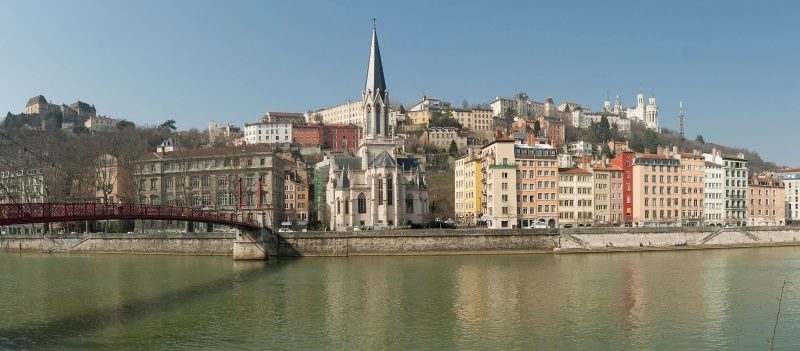The goal of this post is to help you decide whether to stay in Lyon or in Dijon for a short 2 or 3-day stay. Lyon, is France’s third-largest city, just behind Paris and Marseille. It’s 2.3M strong metro area, however, is the second-largest in all France.
Dijon is much smaller with a population of around 155.000 (385.000 for the metro area). It’s in the wine-famous region of Burgundy, a nearly 4-hour drive from Paris.
Lyon Or Dijon: what travelers say

- Neither Lyon or Dijon are towns, they are real cities. Both are interesting to visit and good starting points for touring their respective regions.
- To visit Lyon properly, you need at least 3 days. It’s a relatively large city with good transportation, so Lyon is a good destination if you’re flying or traveling by train.
- Lyon has more things to do than Dijon, although some travelers also report staying in Dijon several days without running out of things to do.
- Dijon is smaller and more compact, cozier, more intimate and walkable than Lyon, making it a better choice for a short 1-day trip.
- Dijon is a better choice than Lyon for visiting the gorgeous surrounding Burgundy countryside and wine routes, and the pretty nearby villages such as Beaune.
- Lyon is famous for its gastronomy, If you’re a foodie, Lyon is your choice. Dijon, however, has a lot of small places offering nice local dishes at very reasonable prices
- In Lyon, you’ll also find abundant green spaces (large and small), and a wide choice of shopping and clubbing spots.
- Lyon is very picturesque, crossed at its core by two rivers, with the modern area resembling Paris in many aspects. Its Old Town is very charming and explorable. The city is known for its ‘traboules’, a network of hidden passages connecting historical buildings.
- In Dijon’s historical center you’ll also find places of architectural interest, and a beautiful central square with numerous restaurants and good animation. The old part of the city has impressive medieval architecture, gargoyles, and museums.
Lyon Or Dijon access & transportation
Lyon is closer if you’re coming from Avignon, while Dijon is closer to Paris. Regular and high-speed rail lines connect the two cities, with several trains per day (1.5 to 2-hour rides).
You can also rent a car to travel between Lyon and Dijon however we don’t recommend driving in the cities because of the many pedestrian and one-way streets and the expensive parking prices.
Dijon is easy to walk while Lyon is more spread out. However, Lyon’s bike rental and subway systems make getting around relatively easy and pleasant. Lyon’s airport is very user-friendly.
Lyon Or Dijon: vibe & people

Some travelers find Lyon exciting and Dijon boring, while others prefer Dijon because it has interesting sights you can see on foot and because it’s smaller and less industrialized than Lyon.
As mentioned, Lyon is a much larger metro area than Dijon, with much more traffic. It’s not as tourist-friendly as other large French cities (like Paris). Even though it’s a large city – with the urban problems that go with it, it feels relatively safe to visit.
There’s a lot to do in Lyon in addition to its renowned gastronomy, such as silk industry historical sights and Italian-influenced Renaissance architecture. There is also a broad array of interesting museums and stunning views of the Rhone.
Dijon is much smaller yet also has great food and interesting history and architecture to offer, though everything is concentrated in a smaller area and there are fewer options compared to Lyon. Aside from the old town, Dijon also has a modern part where most of the shopping (with the usual European chain stores) and the student life takes place.
While Dijon can be visited in a relatively short amount of time, most people combine their visit with tours in the wine country in the surrounding region.
Lyon Or Dijon: sights & culture

Lyon is divided into thirds by the Saone (West) and the Rhone( East) rivers. In between the two rivers is the Presqu’ile (peninsula), the area where most tourists concentrate as it’s a pretty area with narrow streets and old buildings and offers easy access on foot to most areas of interest.
From the Presqu’ile you can cross the river over to the old town (Vieux Lyon) where the oldest architectural sights and historical pedestrian streets are.
On the Presqu’ile, you can visit two of Lyon’s best museums, the ancient medical practices museum facing the Rhone, and a printing museum hosted in a 15th-century mansion – Lyon was a poetry and humanities center during the 16th century.
You also catch the funicular to the Roman ruins and to the Basilique Notre Dame. From there you can walk down the hill alongside gardens with great views, and reach the old town.
Back in the Presqu’ile, visitors enjoy beautiful walks along the river, and at night, can admire the lit Basilique from the Place Bellecour square. You can also walk across the West bridge to the new town and Renaissance district, a UNESCO Heritage site where those mysterious Traboules passageways are hidden.
Lyon also has other great museums including the stunning natural history museum and the dramatic French resistance and deportation museum. The city has about 100 Lyon architectural heritage sites which are lit at night.
Dijon
Dijon also has its share of cultural and historical sites, including a number of ancient churches, the Dukes’ Palace and the Philippe le Bon Tower with its panoramic views, as well as an ample medieval area.
The Hotel Dieu and the Gustave Eiffel designed market are also worth a visit. Dijon has a fascinating archaeological museum with a rare collection of gold Celtic objects, and a great fine arts museum hosted in the Dukes Palace.
The Owl Trail, a frequently-recommended guided walking tour of Dijon, takes you through 22 sights in 3 hours with 3 different loops, including several important museums, galleries, and cafés.
Lyon Or Dijon: food & nightlife

Lyon is considered a food haven by many travelers. Its gastronomy revolves mostly around meats – a heavy and fatty style of cuisine for some (organ meats and cream). There are hundreds of restaurants, ranging from tiny bistros to grand halls, so it’s not always easy to tell which are the authentic ones vs the more touristy ones.
Another option for sampling the Lyon gastronomy is by exploring some of the city’s many markets.
In Dijon, you’ll find inexpensive places to try the renowned Burgundian style, where wines and mustard are the key elements you can visit the Maille mustard store to learn more.
Nightlife is much more vivid in Lyon than in Dijon, with a wide spectrum of bars, pubs, and clubs scattered throughout the city, from local to Latin to Irish. The liveliest places are often found in the Old Lyon.
Lyon also has renowned cultural centers such as the National Opera, the Celestin Theater, and the Lumiere Institute, which all contribute to the city’s cultural influence.
Dijon also has a few happening places in the old town, as well as a few hip clubs. Travelers often recommend the Chat Noir, the Atmosphere, and 88 Club.
Lyon Or Dijon: lodging

Lyon’s Presqu’ile, the central area between the two rivers, is a good place to stay in. It’s a convenient base for visiting various parts of the city on foot, and it hosts the tourist information center.
Travelers often recommend the Hôtel de Célestins for its central location in the Presqu’ile, its quality rooms, air conditioning, and pleasant guest experience. The nearby Hôtel des Artistes is a similarly good option. La Résidence is another well-situated hotel in the same area.
Some travelers recommend renting an apartment here – modern self-catering units hosted in an older building with charm.
In Dijon, travelers recommend La Cloche, one of the oldest and best-known hotels in the city, across the street from the beautiful Darcy park. If you’re driving, however, be aware that parking can be challenging. Some travelers choose to stay in smaller towns between Dijon and Lyon such as Villefranche, Saone, Mâcon, or Beaune – also cheaper and quite charming.
Lyon Or Dijon: day trips

From Lyon, you can drive east to the medieval town of Pérouges or go south and visit the important Roman ruins in Vienne.
Dijon is a great base for day-tripping given its central location in the Burgundy area. Beaune, only 15 minutes by train from Dijon, is a very well-preserved and charming historic town. Dijon and Beaune both offer easy access to the vineyards which you can explore on a rented bike or on foot through the nice trails – not such a common option in other wine regions.
In addition to Beaune, there are many other nice towns to visit in the area such as Flavigny-sur-Ozerain, Semur en Auxois, Paray le Monial, Cluny, Vézelay, and more.
***
Photo credits:
(1) Featured: “Lyon” (CC BY-SA 2.0) by x-oph
(2) “CC134425fs” (CC BY-SA 2.0) by pollobarca2
(3) “Lyon, France” (CC BY-SA 2.0) by szeke
(4) “Dijon, France” (Public Domain) by Philippe Vieux-Jeanton
(5) “Lyon” (CC BY 2.0) by Christine und Hagen Graf
(6) “Lyon” (CC BY 2.0) by schmitt.stelle
(7) “Beaune, Bourgogne” (CC BY-SA 2.0) by DaffyDuke




